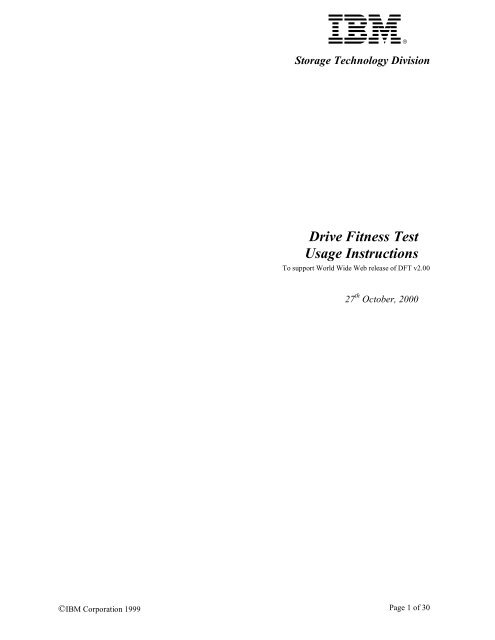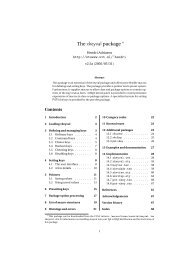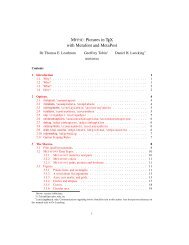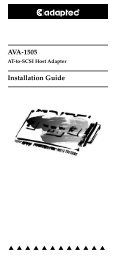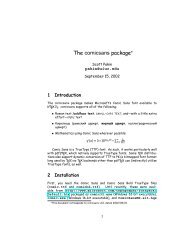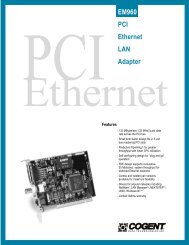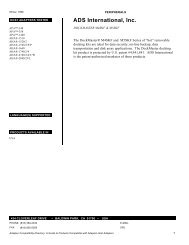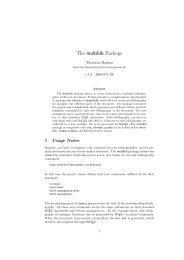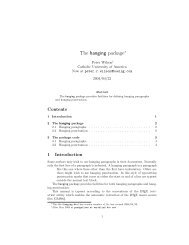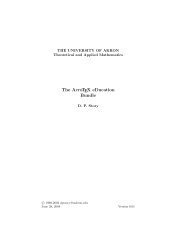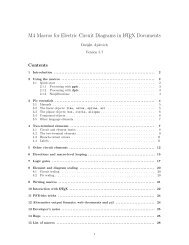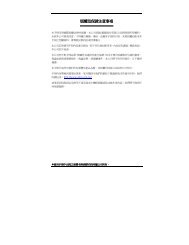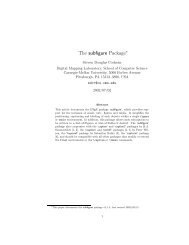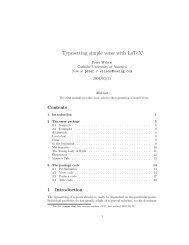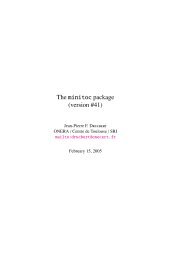Drive Fitness Test Usage Instructions
Drive Fitness Test Usage Instructions
Drive Fitness Test Usage Instructions
- No tags were found...
You also want an ePaper? Increase the reach of your titles
YUMPU automatically turns print PDFs into web optimized ePapers that Google loves.
What is <strong>Drive</strong> <strong>Fitness</strong> <strong>Test</strong>?IBM has a long track record of innovation in the hard disk drive industry, starting with thedevelopment of the first disk drive in 1958. Many technologies common today in disk driveswere first introduced on IBM disk drives, pursuing goals of providing highest performance andcapacity in highly reliable mechanisms within industry standard form factors.One of the latest innovations has been the introduction of <strong>Drive</strong> <strong>Fitness</strong> <strong>Test</strong> (DFT), nowavailable on the Worldwide Web. The purpose of DFT is to test a hard disk drive while itremains inside a personal computer, even when the primary operating system may no longer bebootable. This is suggested when it is suspected that there is a malfunction that could berelated to the hard disk drive. This is helpful, as often problems occur with data content andmanagement unrelated to the function of the disk drive itself. In these cases, a reload of theoperating system, or similar recovery action, is all that will be required to recover thecomputer. This avoids unnecessary disturbance of the disk drive and usually will preserve otherexisting data belonging to the user, which may not have been backed up.The basic <strong>Drive</strong> <strong>Fitness</strong> <strong>Test</strong> (i.e. Quick, Advance and Exerciser) is non-destructive, whichmeans that it will not perform any write operations in the user data area. This option waschosen to ensure the maximum integrity of user data.When run, the <strong>Drive</strong> <strong>Fitness</strong> <strong>Test</strong> will provide a result, from which the condition of the drive -electronics and storage mechanism - can be determined. This can then be used to either chooseto change a drive that is defective, or take other actions to restore the functionality of the PC. Afurther diagnosis may determine that the drive has been subjected to handling damage.In the event that you have a drive which is reported by DFT as defective, then you will beprovided with a Technical Return Code ( TRC ) which will allow you to check and ifappropriate generate a Returns Material Authorisation ( RMA ) via our web based warrantysupport process.In addition to hard drive testing, DFT contains utilities, which allows the following functionsto be carried out: -S.M.A.R.T (Self-Monitoring, Analysis and Reporting Technology) to be enabled ordisabled.Erasure of the disk Master Boot SectorTotal Erasure of the data in the user area of the diskView useful information about the drive, e.g. Microcode level, Spec. Compliance.More information and background about DFT is available fromhttp://www.storage.ibm.com/hardsoft/diskdrdl/technolo/dft/dft.htm©IBM Corporation 1999 Page 3 of 30
DFT System FundamentalsThe <strong>Drive</strong> <strong>Fitness</strong> <strong>Test</strong> is provided for testing IBM disk drives. This new version will support standardIBM disk drives with the ATA/IDE and SCSI interfaces. The test will not overwrite customer data.The <strong>Drive</strong> <strong>Fitness</strong> <strong>Test</strong> (DFT) application is designed to run under DOS and should have been receivedas a executable file dft32-vxxx.exe (where xxx may vary), over the Internet, or as a prepared floppydiskette. If the file has been received over the Internet you will need to follow the procedure below toprepare a suitable diskette.If you have received a prepared floppy, proceed to the section below entitled DFT Hardware Supportand Restrictions.Creating a DFT <strong>Test</strong> DisketteWindows 9x & NTThe <strong>Drive</strong> <strong>Fitness</strong> <strong>Test</strong> set-up program ( dft32-vxxx.exe ) includes IBM PC DOS2000 and the <strong>Drive</strong><strong>Fitness</strong> <strong>Test</strong>. In order to run the set-up program you will need to have access to a system that is runningany of the following operating systems, Windows’95, Windows’98, Windows Millennium, WindowsNT, or Windows 2000 and a formatted 1.44-MB diskette. Running the set-up program creates an IBMPC DOS2000 bootable diskette that contains the <strong>Drive</strong> <strong>Fitness</strong> <strong>Test</strong>.It is recommended that before starting the set-up program, all open Windows applications should beclosed.The following represents two examples of how the DFT diskette can be created.Method A.Method B.1. Insert a formatted diskette into the Floppy drive, (A: or B:).2. Using Windows Explorer, locate the program dft32-vxxx.exe downloaded from theInternet.3. To start diskette creation double-click on the program icon and follow the on screeninstructions. Note: you have the option to select your country location and keyboard layout,the default for these options is United States.1. Click Start, then select Run.2. Click the Browse button to locate the dft32-vxxx.exe set-up program.3. Click on the filename, then click Open.4. Click OK to run the dft32-vxxx.exe set-up program.5. Insert a formatted 1.44-MB diskette into the required floppy drive ( A or B if your systemhas 2 floppy drives ), select the target floppy on the set-up screen then click next tocontinue.6. Follow the on screen instructions.©IBM Corporation 1999 Page 4 of 30
LinuxThe <strong>Drive</strong> <strong>Fitness</strong> <strong>Test</strong> image file (e.g. dft-v200img.bin) includes IBM PC DOS2000 and the IBM <strong>Drive</strong><strong>Fitness</strong> <strong>Test</strong>. The name of the image file will change according to the release version of DFT.Running the Linux Disk Dump (DD) utility creates an IBM PC DOS 2000 bootable diskette thatcontains the <strong>Drive</strong> <strong>Fitness</strong> <strong>Test</strong> Utility.A formatted 1.44-MB diskette is required to create the DFT diskette.To create the bootable DFT diskette under Linux:1. Download the DFT image file (dft-v1.XXimg.bin) into a known directory on your PC.2. Insert a formatted 1.44-MB diskette into your floppy disk drive.3. Make sure that the floppy disk is unmounted.4. Change directory to where you saved the DFT image.5. Run the Disk Dump (DD) utility with the following parameters:DD if=dft-v200img.bin of=/dev/fd0 bs=8k6. The bootable DFT diskette will now be created, Note this could take a couple ofminutes.©IBM Corporation 1999 Page 5 of 30
DFT hardware support and restrictionsDFT will run on ATA and SCSI attached disk drives. It will only support disk drives that have beenmanufactured by IBM.If you have an IBM branded PC, it may or may not contain a disk drive manufactured by IBM. DFT willonly support the disk drive if it is made by IBM. If the disk drive in your IBM PC is from anothermanufacturer, please contact the IBM Personal Systems Group or the relevant drive manufacturer forsupport.DFT will run on IBM SCSI drives if these drives are attached to SCSI controllers that have a DOS ASPIlayer which supports hard drives. Some SCSI controllers have ASPI layers that offer support only forremovable media devices e.g. CD-ROM’s, Tape etc. if you have this type of controller a ASPI Managerthat allows hard disk support will be required in order to test your SCSI hard disk drives using DFT.DFT supports UDMA/33, UDMA/66, and UDMA/100 plug-in PCI-to-ATA adapters from PromiseTechnologies, CMD and adapters based on the HIGHPOINT HPT366 and HPT370 chipset. Windowssees these adapters as SCSI controllers through a non-standard architecture and drives attached to theseadapters will be reported as being attached via PCI adapters.<strong>Drive</strong> configurations NOT supported: drives attached using ATA RAID and Multi-Channel SCSI RAIDcontrollers.©IBM Corporation 1999 Page 6 of 30
SCSI Requirements:To test SCSI drives DFT requires a DOS loadable ASPI manager for the SCSI Controller that the drivesare attached to. Note: Some ASPI managers offer support only for removable media devices e.g.CD-ROM’s, Tape etc. check the documentation that was supplied with your SCSI controllers or contactyour SCSI controller supplier to see if this is the type of ASPI managers you have.DFT is supplied with ASPI managers that support several different types of SCSI controllers, see thesection ‘Supplied ASPI Managers’ at the end of this document. If your SCSI controller is not listed youwill need to obtain a DOS ASPI manager that supports your controller. Check the software suppliedwith your controller or the web page of your controller manufacturer.Having obtained a DOS loadable ASPI manager you will need to update the DFT diskette as follows,1. Copy the ASPI manager program(s) to the ASPI sub-directory on the diskette.2. Using a text editor (e.g. Notepad, Wordpad etc.) edit the file Config.sys on the diskette toinclude the ASPI manager under the SCSI heading.e.g. DEVICE=A:\ASPI\abcdef.sys where adcdef.sys is the name of your ASPI manager.(Your controller documentation should detail how to add an ASPI manager to aconfiguration file).Running DFTPlace the prepared floppy disk in the system to be tested and boot the system either by powering off thenon or pressing the reset button or by pressing the keys.When the system restarts you will be offered a menu with two options1. SCSI and ATA support2. ATA support onlySelect option 2 if you have only or wish to test only ATA drives.Select option 1 if you have only SCSI or a mix of SCSI and ATA drives.Note: the system will attempt to load all the ASPI files listed in theconfig.sys file, if the relevant SCSI controller is not installed in thesystem an error message will be displayed on the screen. This isnormal and isn’t a problem.IBMDFT will be loaded automatically and you will be presented with License Agreement as shownbelow.©IBM Corporation 1999 Page 7 of 30
This is a license agreement, which you should review prior to accepting using the “I Agree” button. Thepositioning and tab keys can be used to navigate through the license agreement and buttons.The program will progress only if the user accepts the license using I agree.DFT will then analyse the connected drives and proceed to the screen belowIf the drives in the list represents what you know to be installed in your system then you should press theYes button, after which you will be presented with the main DFT <strong>Test</strong> Menu, see page 11.©IBM Corporation 1999 Page 8 of 30
If the list doesn’t contain the IBM drive that you wish to test then select No, you will be presented withthe screen below. This window provides information about cabling and jumper settings which couldprevent your drive from being detected, please power-off your system and check that your drive iscorrectly installed and re-start the DFT test. If you have made all the checks and your drive is still notdetected then press the continue button.After pressing the continue button you will be presented with the following screen, type in the serialnumber of the IBM drive that DFT failed to detect and press OK to continue.©IBM Corporation 1999 Page 9 of 30
The following screen shows the Technical Result Code window, this window contains informationwhich you will require in order to use the IBM web based warranty process or when calling theTechnical Support Centre. Please make record this information and press OK when finished.If this is the only IBM drive in your system or the only IBM drive you wished to test when the followingscreen is displayed you can exit the program and shutdown your machine.©IBM Corporation 1999 Page 10 of 30
The following picture shows the main DFT <strong>Test</strong> Menu screen,In this example, there are four drives present in the menu, one ATA hard disk, one ATAPI CD-ROMand two SCSI hard disk, with the ATA drive selected. The path generally to be taken is to select theQuick <strong>Test</strong> simply by pressing the Enter key.©IBM Corporation 1999 Page 11 of 30
Quick <strong>Test</strong>This leads to the next screen. Here the test is ready to start on the selected drive.All that needs to be done is to press enter again to Start the test, which is seen running in the nextscreen.In the screen above, the DFT test is running. The active part of the test is seen to be named (SelectiveMedia <strong>Test</strong> 1), and the progress bar illustrates progress through the active stage. DFT execution for theQuick <strong>Test</strong> should be less than 3 minutes in most circumstances.©IBM Corporation 1999 Page 12 of 30
Error Code and first aid for your driveError code 0x70 as shown on the previous page, indicates that your hard disk drive has one ormore bad sectors. In most of these cases the drive can heal itself of these errors. To do this firstback-up all your data on the problem drive ( if possible ) then run DFT again and select theErase disk option which is under the Utilities heading. Once erase disk has completed you canthen run one of the test options Quick or Advance to confirm that the drive has been healed.The result code, which should be displayed, is 0x00 if the test returns another code then returnthe drive for warranty replacement.©IBM Corporation 1999 Page 14 of 30
The next screen shows an example of a non-media test failure.In this case, the failing return code 0x72 represents a S.M.A.R.T. error. The S.M.A.R.T. system is a diskdrive’s way of notifying of possible failure in the future (see Utilities Section for more information onS.M.A.R.T).In all cases of test failures the following screen will be displayed.In all cases the test result should be noted as it may be required in discussion with your supplier orsupport centre in order to take steps to replace the hard drive or to obtain a RMA (return materialsauthorisation) through the IBM web based warranty process.©IBM Corporation 1999 Page 15 of 30
If the test is stopped, for example by pressing the cancel button during test, the following will appear.If Yes is selected, then the test will be stopped as shown in the next screen.This says that testing has not been completed, and is not a statement of either pass or fail. <strong>Test</strong>ing mustbe restarted and completed normally. The return code 0x10 is not an error.©IBM Corporation 1999 Page 16 of 30
Advanced <strong>Test</strong>If the Advanced <strong>Test</strong> option is selected, testing is similar to Quick <strong>Test</strong>, but all of the data area of theselected disk drive will be tested.DFT only performs a read test in the user data area, so your data will not be overwritten. Execution timewill normally be up to about 40 minutes, but this can be longer for very large capacity drives. Progresswill be illustrated as shown here.©IBM Corporation 1999 Page 17 of 30
Advanced TopicsMenusUse F10 to select the highlighted DOS menu keys, as illustrated below. These are generally repeatfunctions but also allow access to additional tests and utilities.The Exerciser test, as shown in the next screen, can be accessed from the menu or by using the Alt-Ekey combination.©IBM Corporation 1999 Page 18 of 30
The Exerciser is an Advanced <strong>Test</strong> with the addition of a number of additional 30 minute drive tests.The number of these 30 minute periods is set in the following screen. The pass / fail / abort mechanismis similar to that of Quick <strong>Test</strong>.©IBM Corporation 1999 Page 19 of 30
UtilitiesThe Utilities menu as shown below, gives you access to several useful tools. These should be used withCARE, for unlike the test described earlier the Erase Boot Sector and Erase Disk utilities WILLpermanently erase data from your drive(s).Selection of the <strong>Drive</strong> Info. Option as shown above will display useful information about the selecteddrive, see following screen. This information will be useful if you need to report a problem back to yourdrive supplier or IBM.©IBM Corporation 1999 Page 20 of 30
The drive information displayed above can be saved to a text file in the data sub-directory on the floppydrive. The default name of the text file is DRVINFO.TXT as shown below, you can change the filenameby typing over this name with for example the drive serial number.The following screen will be displayed to confirm that the file has been saved.©IBM Corporation 1999 Page 21 of 30
Erase Boot SectorThe boot sector of a disk contains the start-up programs for your operating system, it also containsinformation about how your disk is partitioned. If this sector becomes corrupted in any way and this isyour boot drive you may not be able to start your system or access data on the drive. Re-installation ofyour operating system in a small number of cases may not fix the problem, for these cases you will needto erase the boot sector, partition the drive and re-install your operating system.This utility will erase the boot sector by over writing the original information in this sectorwith zeros. It can be used with both IDE and SCSI drives.Selecting Erase Boot Sector from the Utilities menu above will display the following screen©IBM Corporation 1999 Page 22 of 30
This utility will overwrite data on your hard drive, to ensure that you really wish to do this you will bepresented with several confirmation screens as shown below, select YES in each case to continue.The following screen will be displayed when the operation has been completed successfully.©IBM Corporation 1999 Page 23 of 30
Erase DiskThis utility will write zeroes to every sector of your hard drive including the boot sector, and can be usedwith both IDE and SCSI drives. This utility is meant to be used to clean-up disk which have errorswritten to the media (e.g. where a system has been powered off whilst writing data out to the drive). Thisutility can take a long time to run (more than an hour) depending on the capacity of the drive and thesystem configuration.Selecting Erase Disk from the Utilities menu above will display the following screen©IBM Corporation 1999 Page 24 of 30
As with the Erase Boot Sector utility, Erase Disk will overwrite data on your hard drive, to ensure thatyou really wish to do this you will be presented with several confirmation screens as shown below, selectyes in each case to continueProgress will be illustrated as shown below©IBM Corporation 1999 Page 25 of 30
The following screen will be displayed when the operation has been completed successfully.©IBM Corporation 1999 Page 26 of 30
ATA FunctionsS.M.A.R.T Operations.S.M.A.R.T. - Self-Monitoring, Analysis and Reporting Technology is intended to protect user data andprevent unscheduled system downtime that may be caused by predictable degradation and/or fault of thedisk device. By monitoring and storing critical performance and calibration parameters, S.M.A.R.T.devices employ sophisticated data analysis algorithms to predict the likelihood of near-term degradationor fault conditions.To enable/disable S.M.A.R.T., select S.M.A.R.T. Operations from the utilities menu as shown above,S.M.A.R.T. can now be enabled or disabled on the selected drive by selecting enable/disable as shownbelow.©IBM Corporation 1999 Page 27 of 30
Supplied ASPI ManagersThe following ASPI managers are supplied with the DFT Utility and provide support for the listed SCSIControllers.ASPI Manager Version Supported ControllersASPI2DOS.SYS02-12-98ASPI4DOS.SYS26-04-99ASPI8DOS.SYS02-12-98ASPI8U2.SYS06-12-993.683.36S1.351.07xxxxxxxxxxxxxxxxxxxAdaptec AVA-1502P,1502APAdaptec AVA-1505Adaptec AVA-1515Adaptec AHA-1510/1520/1522Adaptec AHA-1510A/1520A/1522AAdaptec AHA-1510B/1520B/1522BAdaptec AHA-1530P/1532PAdaptec AVA-1502AE/AI,AVA-1505AE/AI,AVA-1505AESAdaptec AIC-6260/6360/6370 based SCSI host adaptersAdaptec AVA-2825 host adapterAdaptec AHA-1540B/1542BAdaptec AHA-1540C/1542CAdaptec AHA-1540CF/1542CFAdaptec AHA-1540CP/1542CPAdaptec 2940 family of PCI to SCSIMotherboards with SCSI onboard – that uses Adaptec AIC-78XX andAIC-75XX chipsetAdaptec Dual & Single Channel Ultra2 family of PCI to SCSI ControllersAdaptec Dual & Single Channel ULTRA160 PCI to SCSI ControllersMotherboards with SCSI onboard – that uses Adaptec AIC-7890 and AIC-7891 chipset.ASPI8XX.SYS13-04-994.06.00xxSymbios SYM8751SP Single ended ControllerMotherboards with SCSI onboard – that uses Symbios 53C875J chipset.DPTDDL.SYS31-03-98ISPI610.SYS16-04-97003.EH x DPT PM3334UW Single Channel Raid Controller1.04 x Initio INI-6100 / 6102 SCSI ControllersISPI910.SYS06-04-972.01xxInitio INI-9100 / 9100W SCSI ControllersInitio INI-9XXXU / 9XXXUW SCSI ControllersBTDOSM.SYS26-04-99ADV3550.SYS15-05-98ADVASPI.SYS19-05-98ASPIUWF.SYS16-07-994.30 x BusLogic BT-946C3.1F x Advansys Ultra Wide ASPI Manager2.8N x Advansys Universal ASPI Manager3.21 x Tekram DC-390U/W/F/U2 and DC-310/U©IBM Corporation 1999 Page 28 of 30
TroubleshootingASPI Manager Fails to LoadNote: Some implementation of SCSI on the Motherboard using the Adaptec AIC-7890 chipset willresult in the ASPI Manager ASPI8U2.SYS (version 1.07), which is supplied on this DFT diskette,failing to load. Should this be the case and you are sure your SCSI controller is built around this chipsetthen you should replace the file ASPI8U2.SYS in the A:\ASPI sub-directory of the diskette with theASPI8U2.SYS which should have been supplied as part of the software support package for yourhardware.Unsupported PCI IDE AdapterThere are some instanced where DFT when loading may display a message similar to that below. Notethis is not an error condition but just a message to alert you that DFT does not recognise the chipsetbeing used to control the PCI IDE Buses in your system. It is also a request for you to send the Vendorand Device ID codes to IBM Technical Support as indicated in the message so that future releases ofDFT can cater for this chipset.©IBM Corporation 1999 Page 29 of 30
<strong>Drive</strong>s Attached to PCI IDE Adapter not seen by DFTIf using a Plug-in PCI IDE adapter that uses the Highpoint HPT366 chipset in some systemsDFT will fail to detect drives attached to this adapter. To fix this problem ensure that the PCIIDE adapter BIOS is upgraded to the latest level. For example if using the EPUSB66 adapterthen you will need to have BIOS level 1.25 or above.BIOS updates can be obtained from the following web site: -http://www.highpoint-tech.com/drivers.htm©IBM Corporation 1999 Page 30 of 30


